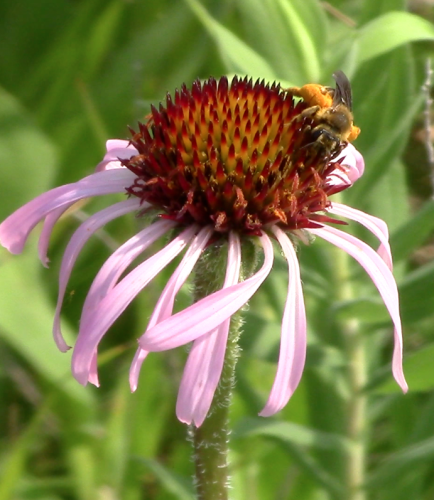
Andrena. A still from the video below. Pollinator Efficiency Project 2014
Family: Adrenidae
Genus: Andrena
Common Name: Mining Bees
Length: 7-18 mm (0.3-0.7 in)
Link to DiscoverLife: Andrena Female and Andrena Male
Identification: Andrena are black, dull metallic blue, or green and moderately hairy, with bands of pale hair on their abdomens. The females have large, velvety facial depressions (foveae) that look like eyebrows and large pollen-collecting hairs (scopae) on the upper part of their hind legs (in their “armpits”). They are similar in size and color to Colletes and Halictus, but these lack the stripes on the abdomen that Andrena has.
Foraging Habits: Both generalists and specialists. Andrena are the most common spring foragers, out collecting as early as February!
Nesting Habits: Andrena individuals are both solitary and communal. All Andrena nest in the ground, usually in sandy soil and near or under shrubs. Usually the entrance is marked by a small mound (tumulus) of soil. The female lines her brood cells with a material she secretes from a specialized gland, which soaks into the soil, then is dried and forms a polished and stable cell wall. Many species make nests in large aggregations of tens of thousands of bees, but within that the individual bees are solitary. Some species nest communally, where two or more females share a nest entrance but build and support their own brood cells.
Specimens in Collection: 33 specimens
Species Observed: Andrena rudbeckiae
Supplemental Images: Andrena rudbeckiae (female), Andrena rudbeckiae (male)
(Mader et al. Attracting Native Pollinators: Protecting North America’s Bees and Butterflies. 2011. The Xerces Society.)
The Andrena slowly and precisely circumnavigates the flower head again and again in her search for pollen, digging her head down to reach pollen lower on the anthers. More videos of bees visiting Echinacea can be found on The Echinacea Project Youtube.
